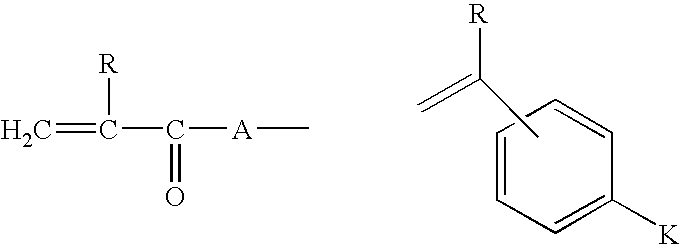Crosslinked polymers and refractive devices formed therefrom
a technology which is applied in the field of crosslinked polymers and refractive devices formed therefrom, can solve the problem of relatively low refractive index of gels
- Summary
- Abstract
- Description
- Claims
- Application Information
AI Technical Summary
Problems solved by technology
Method used
Image
Examples
example 2
Further polymerisations to form membranes were conducted using the general method, to investigate the effect on the EWC, RI and transmission, and also the mechanical characteristics and biocompatibility, of changing the relative amounts of zwitterionic and aromatic group containing monomer. The biocompatibility is, in this experiment determined using the fibrinogen adsorption test described above, the control being a polymer of 98% mole benzyl methacrylate and 1% each (mole) of EGDMA and BADMA crosslinker. The monomer proportions are shown in Table 2. The results are shown in Table 3. The results show that the strain for materials formed from monomers including lauryl methacrylate in place of benzylacrylate is reduced. The results of example 2.1-2.5 show that polymers having PC groups can be formed with good mechanical and optical properties and which have good biocompatibility as adjudged by the reduction of fibrinogen adsorption.
TABLE 3
example 3
Polymerisations in Button Moulds
In this and the following example the effects of changing the type of cross-linker, the level of initiator and the level of solvent on optical and mechanical properties are investigated.
Monomers at the mole proportions shown in Table 5 were polymerised by the general method. All polymerisation contained 15 mole % HEMA-PC and the remaining amount after taking the cross-linker quantities into consideration was BA. The EF, hydrated optical clarity, EWC and hardness of the variant buttons are shown in Table 5.
TABLE 5
example 4
Slices of some of the buttons made in Example 3 were subjected to mechanical tests to give the results shown in Table 6.
Discussion of Example 3 and 4
Crosslinker
The standard formulation HEMA-PC:BA:EGDMA:BADMA 15:83:1:1 was altered to use only one crosslinker, 2 mol % EGDMA or 2 mol % BADMA The production of 2% BADMA was unsuccessful resulting in white soft buttons due to phase separation. The complete removal of EGDMA from the polymer is unfavourable, as it seems to result in a loss of clarity.
Decreasing the level of BADMA from 2 to 0 mol %, and increasing the EGDMA level to maintain 2 mol % crosslinker level overall, results in buttons which have a higher expansion factor, higher water content and therefore reduced mechanical properties. This trend is shown clearly in Table 5 and 6. Increasing the EGDMA level at the expense of BADMA increases the water content due to the hydrophobic nature of BADMA.
Reducing Solvent Level
In the general method 20 wt % solvent was incorporated into the...
PUM
| Property | Measurement | Unit |
|---|---|---|
| Fraction | aaaaa | aaaaa |
| Fraction | aaaaa | aaaaa |
| Fraction | aaaaa | aaaaa |
Abstract
Description
Claims
Application Information
 Login to View More
Login to View More - R&D
- Intellectual Property
- Life Sciences
- Materials
- Tech Scout
- Unparalleled Data Quality
- Higher Quality Content
- 60% Fewer Hallucinations
Browse by: Latest US Patents, China's latest patents, Technical Efficacy Thesaurus, Application Domain, Technology Topic, Popular Technical Reports.
© 2025 PatSnap. All rights reserved.Legal|Privacy policy|Modern Slavery Act Transparency Statement|Sitemap|About US| Contact US: help@patsnap.com



